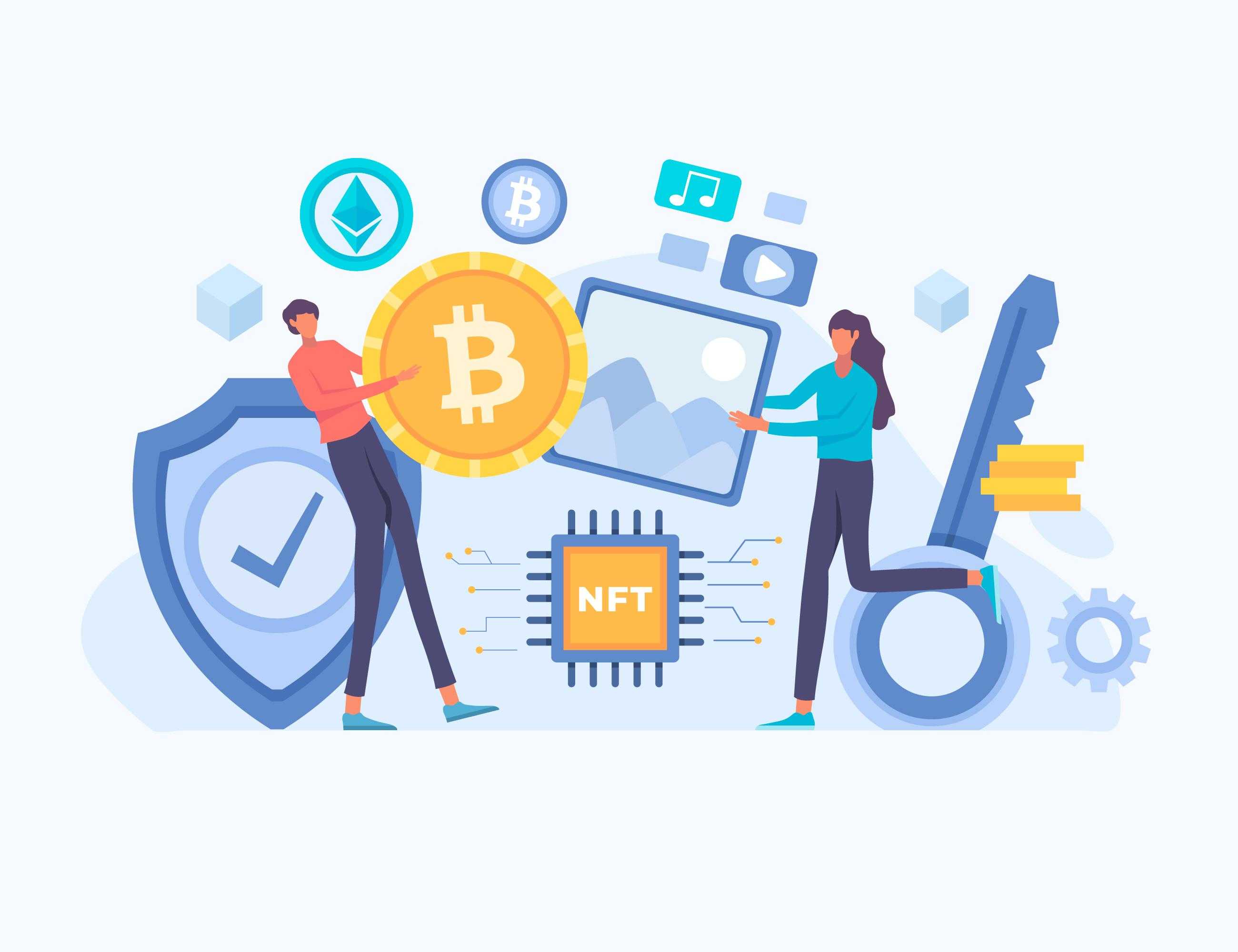Search Buzz Words
- Bitcoin
- Bitcoin is a decentralized digital currency that enables peer-to-peer transactions without the need for intermediaries such as banks or governments. It is based on a decentralized ledger technology called blockchain.
- Blockchain
- Blockchain is a decentralized ledger technology that allows data to be stored in a tamper-evident and secure way. It is the underlying technology that powers cryptocurrencies such as Bitcoin.
- Ethereum
- Ethereum is an open-source, decentralized blockchain platform that enables the creation of decentralized applications and smart contracts. Its cryptocurrency is called Ether.
- Altcoins
- Altcoins refer to any cryptocurrency other than Bitcoin. Examples include Ethereum, Litecoin, and Dogecoin.
- Hodl
- Hodl is a term used by cryptocurrency enthusiasts to describe the act of holding onto their cryptocurrency investments even during times of market volatility, rather than selling them.
- Decentralized Finance (DeFi)
- Decentralized Finance (DeFi) is a movement to create a decentralized financial system that is open, transparent, and accessible to anyone with an internet connection. It is built on blockchain technology and is often associated with cryptocurrencies.
- Smart contracts
- Smart contracts are self-executing contracts that are encoded on a blockchain. They allow for the automatic execution of transactions and the enforcement of contract terms without the need for intermediaries.
- Liquidity
- Liquidity refers to the ease with which an asset can be bought or sold on the market without significantly affecting its price. High liquidity means that an asset can be bought or sold quickly and at a fair price.
- Market cap
- Market cap, short for market capitalization, is a measure of the total value of a company or asset. In the context of cryptocurrency, it is calculated by multiplying the price of a cryptocurrency by the number of units in circulation.
- Trading range
- Trading range refers to the difference between the highest and lowest prices of an asset during a given time period. It is often used by traders to identify support and resistance levels.
- Volume
- Volume refers to the total number of units of an asset that have been traded during a given time period. It is often used as an indicator of market liquidity and momentum.
- Resistance
- Resistance is a price level at which an asset tends to encounter selling pressure, causing it to fall in price. It is often used by traders to identify potential selling opportunities.
- Support
- Support is a price level at which an asset tends to encounter buying pressure, causing it to rise in price. It is often used by traders to identify potential buying opportunities.
- Candlestick chart
- A candlestick chart is a type of chart used by traders to visualize price movements of an asset. It displays the open, high, low, and close prices for a given time period in a visually appealing way.
- Moving average
- A moving average is a technical indicator used by traders to identify trends in an asset's price. It is calculated by averaging the prices of an asset over a given time period.
- Bollinger Bands
- Bollinger Bands is a technical analysis tool that is used to measure market volatility and identify potential price trends. It consists of three lines: a simple moving average in the middle, and an upper and lower band that are plotted at a certain number of standard deviations away from the moving average.
- Relative Strength Index (RSI)
- Relative Strength Index (RSI) is a momentum oscillator that measures the magnitude of recent price changes to evaluate overbought or oversold conditions in the price of a financial asset. It ranges from 0 to 100 and is often used as an indicator to help identify potential trading opportunities.
- MACD (Moving Average Convergence Divergence)
- MACD (Moving Average Convergence Divergence) is a trend-following momentum indicator that is used to identify changes in the strength, direction, and duration of a trend in a financial asset's price. It is calculated using two moving averages of different periods and is plotted as a histogram, which can help traders identify potential buy or sell signals.
- Fibonacci retracement
- Fibonacci retracement is a technical analysis tool that is based on the idea that financial asset prices tend to retrace a predictable portion of a move after an impulse. It uses horizontal lines to indicate areas of support or resistance at the key Fibonacci levels before the price continues in the original direction. It is often used to identify potential entry and exit points in a financial asset's price trend.
- VWAP (Volume Weighted Average Price)
- VWAP (Volume Weighted Average Price) is a technical analysis tool that calculates the average price of a financial asset based on its volume and price over a given period. It is often used by traders to identify the average price of a financial asset and to make trading decisions based on that price.
- Non-fungible tokens (NFTs)
- Non-fungible tokens (NFTs) are unique digital assets that are stored on a blockchain, making them immutable and impossible to duplicate or replicate. They can represent various types of assets, such as digital art, music, and collectibles, and are often bought and sold on cryptocurrency marketplaces.
- Stablecoins
- Stablecoins are a type of cryptocurrency that is designed to maintain a stable value relative to a particular asset or currency, such as the US dollar. They can provide a stable store of value and are often used to facilitate cryptocurrency trading and transactions, as well as to provide a hedge against cryptocurrency market volatility.
- Margin trading
- Margin trading is a trading method that allows traders to borrow funds from a broker or exchange to trade financial assets with a larger position size than they could with their own capital. This can increase potential profits, but also increases the risk of losses and requires careful risk management.
- Leverage
- Leverage refers to the ability to control a large position in a financial asset with a relatively small amount of capital. It is often used in margin trading and can amplify both potential gains and losses.
- Mining
- Mining refers to the process of validating transactions and adding new blocks to a blockchain. In the context of cryptocurrency, mining involves solving complex mathematical equations using specialized computer hardware, with successful miners rewarded with newly minted cryptocurrency as an incentive for their work.
- Pump and dump
- Pump and dump is a type of market manipulation scheme where a group of people artificially inflate the price of an asset by spreading false or misleading information, and then sell off their holdings at a profit once the price has risen. This leaves other investors with losses, as the price typically crashes after the pumpers sell off.
- FOMO (Fear of Missing Out)
- FOMO, or fear of missing out, is a psychological phenomenon where an individual feels anxious or worried about missing out on a potentially profitable opportunity or experience. In the context of cryptocurrency, FOMO can cause individuals to make impulsive decisions and invest in assets based on hype and speculation, rather than sound analysis and research.
- FUD (Fear, Uncertainty, and Doubt)
- FUD, or fear, uncertainty, and doubt, is a tactic used by some individuals or groups to spread negative or misleading information about a particular asset or market, in order to create doubt or fear among investors and discourage them from investing or holding the asset. FUD can be spread through social media, news outlets, or other channels.
- Whitepaper
- A whitepaper is a document that explains the details and specifications of a new technology, product, or concept. In the context of cryptocurrency, whitepapers are often used to introduce new blockchain projects and explain how they will function. They typically include information on the project's goals, features, technical specifications, and other details.
- Order book
- An order book is a list of all the open buy and sell orders for a particular asset on an exchange. The order book shows the quantity of each order and the price at which the buyer or seller is willing to trade. Traders can use the order book to analyze market depth and liquidity, and to place their own orders.
- Price action
- Price action is a term used to describe the movement of an asset's price over time. Traders who use price action analysis focus on studying historical price data and identifying patterns or trends that can help them predict future price movements. Price action can be analyzed through the use of technical indicators, chart patterns, and other tools.
- Breakout
- A breakout is a technical analysis term used to describe a situation where an asset's price breaks through a resistance level or support level. This can be a bullish or bearish signal, depending on the direction of the breakout. Traders often use breakout strategies to identify potential trading opportunities.
- Pullback
- A pullback is a temporary reversal in an asset's price after a significant move in one direction. This can occur when traders take profits or when new traders enter the market and buy or sell the asset. Pullbacks are often seen as a buying opportunity for traders who missed the initial move.
- Consolidation
- Consolidation is a period of relatively low volatility in an asset's price, where the price tends to move within a relatively narrow range. This can occur after a period of strong buying or selling activity, as traders wait for new developments or catalysts before making further moves.
- Divergence
- Divergence is a term used in technical analysis to describe a situation where the price of an asset moves in a different direction than a particular indicator or other technical signal. This can be a signal of a potential reversal in the asset's price trend.
- Convergence
- Convergence refers to the coming together or intersection of two or more different indicators, trends or moving averages on a chart. In technical analysis, convergence is often used as a signal that a trend reversal or significant price move may be imminent.
- Volatility
- Volatility is a statistical measure of the degree of variation or dispersion of returns on an investment or market index. In finance, volatility is often used as a measure of risk, with higher volatility indicating greater potential for large price swings in either direction.
- Whale watching
- Whale watching refers to the practice of monitoring large individual investors or entities, known as "whales," in the cryptocurrency market. This is done because the actions of these whales, who often hold a large percentage of a particular cryptocurrency, can have a significant impact on the overall market price.
- Buy wall
- A buy wall is an order book phenomenon that occurs when there is a large concentration of buy orders at a specific price level for a particular cryptocurrency. The buy wall can create a psychological barrier that prevents the price from dropping below that level, as traders may believe that there is strong demand for the asset at that price.
- Sell wall
- A sell wall is the opposite of a buy wall and occurs when there is a large concentration of sell orders at a specific price level for a particular cryptocurrency. The sell wall can create a psychological barrier that prevents the price from rising above that level, as traders may believe that there is strong supply of the asset at that price.
- Candlestick patterns
- Candlestick patterns are visual representations of price movements for a particular asset, commonly used in technical analysis. These patterns are formed by a series of candlesticks on a chart, and are used to identify potential trend reversals or continuation patterns.
- Fibonacci levels
- Fibonacci levels are horizontal lines that are drawn on a chart to indicate areas of potential support or resistance. These levels are derived from the Fibonacci sequence and are commonly used in technical analysis to identify potential price targets, retracement levels, and support and resistance levels.
- RSI divergence
- RSI divergence occurs when the price of a cryptocurrency and the Relative Strength Index (RSI) are moving in opposite directions. This is considered a potential warning sign that a trend reversal may be imminent, as it suggests that momentum is decreasing or changing direction.
- Ichimoku Cloud
- The Ichimoku Cloud is a technical analysis tool used to identify potential buy and sell signals for a particular asset. The cloud is composed of several different components, including a moving average, and is designed to provide traders with a comprehensive view of price action and trend direction.
- Elliott Wave Theory
- Elliott Wave Theory is a method of technical analysis used to analyze financial market cycles and forecast market trends based on wave patterns. It suggests that market trends move in waves, with each wave having a specific pattern and duration.
- Market depth
- Market depth refers to the level of buying and selling interest for a particular asset at different price levels. It is usually represented in the form of an order book and shows the number of buy and sell orders at various price levels.
- Hard fork
- A hard fork is a radical change to a blockchain protocol that results in the creation of a new version of the blockchain, which is not compatible with the previous version. It usually involves a change to the consensus rules of the blockchain, and can result in the creation of a new cryptocurrency.
- Soft fork
- A soft fork is a minor change to a blockchain protocol that is compatible with the previous version. It involves a change to the consensus rules of the blockchain that does not result in the creation of a new cryptocurrency.
- Gas fees
- Gas fees are fees paid by users to miners on a blockchain network for the processing of transactions. The fees are paid in the native cryptocurrency of the blockchain and are used to incentivize miners to process transactions quickly and efficiently.
- Distributed ledger technology (DLT)
- Distributed ledger technology (DLT) is a digital system for recording and sharing information across a network of computers. It is used to maintain a tamper-proof and transparent record of transactions and other information, and is the underlying technology behind cryptocurrencies like Bitcoin.
- Public key
- A public key is a cryptographic key that is used to receive cryptocurrency payments. It is a long string of alphanumeric characters that is publicly visible and can be shared with anyone who wants to send a cryptocurrency payment to the owner of the key.
- Private key
- A private key is a cryptographic key that is used to send cryptocurrency payments. It is a long string of alphanumeric characters that is kept secret by the owner of the key and is used to sign and verify transactions on the blockchain network.
- Wallet
- A wallet is a digital or physical device used to store cryptocurrencies. It stores the public and private keys that are used to send and receive cryptocurrency payments and allows users to view their balances and transaction history.
- Hardware wallet
- A hardware wallet is a physical device used to store cryptocurrencies. It is considered to be one of the most secure methods of storing cryptocurrencies, as it stores the private keys in a secure offline environment, making it less vulnerable to hacking attacks.
- Paper wallet
- A paper wallet is a physical document that contains the public and private keys for a cryptocurrency address. It is usually printed on paper or written by hand, and is considered to be a secure method of storing cryptocurrencies as it is not connected to the internet and is less vulnerable to hacking attacks.
- Seed phrase
- A seed phrase, also known as a recovery phrase, is a list of words used to backup and restore a cryptocurrency wallet. The seed phrase usually consists of 12 to 24 words in a specific order that must be kept secret and secure as it can be used to access the funds stored in the wallet.
- Cold storage
- Cold storage is a security measure used to store cryptocurrency offline, where the private keys are kept on a device that is not connected to the internet. This is considered to be a more secure method of storing cryptocurrency than keeping it in a hot wallet or online exchange.
- Hot wallet
- A hot wallet is a cryptocurrency wallet that is connected to the internet and allows for quick access to funds. Hot wallets are often used for small amounts of cryptocurrency and are more susceptible to hacking and theft compared to cold storage.
- Stop loss hunting
- Stop loss hunting is a practice used by traders to intentionally trigger stop loss orders set by other traders, causing the price to drop and allowing the first traders to buy at a lower price. This is considered to be a manipulative and unethical practice.
- Front-running
- Front-running is a practice used by traders to buy or sell a cryptocurrency before a larger order is executed, taking advantage of the expected price movement. This is considered to be an unethical practice.
- Spoofing
- Spoofing is a practice used by traders to manipulate the price of a cryptocurrency by placing fake buy or sell orders to create the illusion of demand or supply. Once the price moves in the desired direction, the fake orders are canceled, and the trader profits from the price movement.
- Wash trading
- Wash trading is a practice used by traders to manipulate the trading volume of a cryptocurrency by buying and selling to themselves, creating the illusion of activity and volume. This is considered to be an unethical practice.
- Arbitrage
- Arbitrage is the practice of buying a cryptocurrency on one exchange and selling it on another exchange simultaneously, taking advantage of price differences between the two exchanges. This is considered to be a legitimate and common trading strategy.
- Dollar-cost averaging (DCA)
- Dollar-cost averaging (DCA) is an investment strategy where an investor buys a fixed amount of a cryptocurrency at regular intervals, regardless of the price. This helps to average out the cost of the investment and reduce the impact of price volatility.
- Buy the dip
- Buy the dip is a strategy where an investor buys a cryptocurrency when the price has experienced a sudden drop, anticipating a price recovery in the near future. This strategy assumes that the price will eventually rebound and result in a profitable investment.
- Sell the rip
- Sell the rip is a strategy where an investor sells a cryptocurrency when the price has experienced a sudden increase, anticipating a price correction in the near future. This strategy assumes that the price will eventually decline and result in a profitable sale.
- Short
- Shorting, or "going short," is a trading strategy in which an investor sells a security that they do not own, hoping to profit from a price decline. To do this, the investor borrows the security from a broker and immediately sells it, hoping to buy it back at a lower price and return it to the broker, pocketing the difference.
- Long
- Going long, or "long position," is a trading strategy in which an investor purchases a security with the expectation that its price will increase over time. In this strategy, the investor hopes to sell the security at a higher price than the purchase price, realizing a profit.
- Swing trading
- Swing trading is a trading strategy that involves buying and holding a security for a short period of time, usually from a few days to a few weeks, in order to profit from price swings or "swings" in the market.
- Day trading
- Day trading is a trading strategy in which an investor buys and sells securities within the same trading day, closing all positions before the market closes for the day. Day traders aim to profit from small price movements and typically use leverage to increase their potential profits.
- Position trading
- Position trading is a trading strategy in which an investor takes a long-term position in a security, holding it for weeks, months, or even years. Position traders aim to profit from the long-term price trends of the security and often use fundamental analysis to make their trading decisions.
- Scalping
- Scalping is a trading strategy that involves making many small trades in quick succession, attempting to profit from small price movements. Scalpers hold their positions for only a few seconds to a few minutes and rely heavily on technical analysis and charting tools to make trading decisions.
- HFT (High-Frequency Trading)
- High-frequency trading (HFT) is a trading strategy that uses powerful computers and algorithms to make trades at incredibly high speeds, often executing orders in a fraction of a second. HFT is used by professional traders and hedge funds to profit from small price discrepancies across different markets and securities.
- ERC-20 tokens
- ERC-20 tokens are digital assets that are built on the Ethereum blockchain and adhere to a specific set of rules and standards. These tokens are fungible and can be traded or exchanged for other ERC-20 tokens or cryptocurrencies. Many ICOs (Initial Coin Offerings) issue ERC-20 tokens to raise funds for their projects.
- Mainnet
- Mainnet refers to the main blockchain network of a particular cryptocurrency. It is the live and operational version of the blockchain, where all transactions are validated and recorded by the nodes on the network. The mainnet is the backbone of the cryptocurrency and is where all the action happens.
- Testnet
- Testnet is a test blockchain network that is used for developers and users to test and experiment with new applications, smart contracts, and other features of the blockchain without risking real cryptocurrency or assets. Testnet operates separately from the mainnet and usually has its own tokens or coins that have no real-world value.
- Fork resistance
- Fork resistance is the ability of a cryptocurrency network to resist forking into multiple chains due to a software upgrade or a disagreement within the community. A high level of fork resistance indicates that the network is strong and stable.
- Hash rate
- Hash rate refers to the computing power used to process transactions and create new blocks in a blockchain network. A higher hash rate means more computing power is being used, which can increase network security and transaction speed.
- Liquidation
- Liquidation refers to the process of closing out a trader's positions on an exchange when the trader's margin balance falls below the required minimum. This is done to prevent further losses and protect the exchange from default.
- Short squeeze
- A short squeeze is a market condition in which the price of an asset increases rapidly, forcing traders who had shorted the asset to buy it back at a higher price to minimize their losses. This buying pressure can lead to a further increase in the price of the asset.
- Long squeeze
- A long squeeze is a market condition in which the price of an asset decreases rapidly, forcing traders who had taken long positions to sell the asset at a lower price to avoid further losses. This selling pressure can lead to a further decrease in the price of the asset.
- Volatility index
- A volatility index is a measure of the expected volatility of an asset over a specific period of time. It is often used as an indicator of investor sentiment and market risk.
- Fear and greed index
- The fear and greed index is a market sentiment indicator that measures the emotions of market participants towards a specific asset or market. It is calculated based on various factors such as volatility, volume, and social media sentiment.
- Whales
- In the cryptocurrency market, whales are individuals or organizations that hold a large amount of a particular cryptocurrency. Their buying and selling activities can have a significant impact on the price of the cryptocurrency.
- Bulls
- Bulls are investors who are optimistic about the price of an asset and believe that it will increase in value. They often buy the asset in the hope of selling it at a higher price in the future.
- Bears
- Bears are investors who are pessimistic about the price of an asset and believe that it will decrease in value. They often sell the asset in the hope of buying it back at a lower price in the future.
- Margin call
- A margin call is a request from a broker or exchange for a trader to add more funds to their margin account when the value of their positions falls below a certain level. This is done to ensure that the trader has enough collateral to cover potential losses.
- Front-running
- Front-running refers to the practice of entering into a trade or transaction with advance knowledge of pending orders from other market participants. This can be done to profit from the anticipated price movement resulting from those orders.
- Spoofing
- Spoofing is the act of placing orders to buy or sell an asset with the intent to cancel those orders before they are executed. The goal of spoofing is to manipulate the market by creating a false impression of supply or demand.
- Wash trading
- Wash trading is the practice of simultaneously buying and selling the same asset to create the illusion of trading volume and price movement. This can be done to manipulate the market or to make an asset appear more popular or valuable than it actually is.
- Mining pool
- A mining pool is a group of miners who combine their computing power to increase their chances of finding a block and earning rewards. By pooling resources, miners can share the computational workload and receive a portion of the block reward in proportion to their contributed computing power.
- Halving
- A halving is a pre-programmed event that reduces the block reward miners receive for adding a new block to the blockchain. This is typically done to control the inflation rate of a cryptocurrency by gradually reducing the supply of newly-minted coins over time.
- Proof of work (PoW)
- Proof of work is a consensus algorithm used to validate transactions and add new blocks to a blockchain. In PoW, miners compete to solve a complex cryptographic puzzle, and the first one to solve it earns the right to add the next block to the chain. The difficulty of the puzzle is adjusted regularly to maintain a consistent block time.
- Proof of stake (PoS)
- Proof of stake is a consensus algorithm used to validate transactions and add new blocks to a blockchain. In PoS, validators are chosen to create new blocks based on the amount of cryptocurrency they have staked (i.e., locked up as collateral). This is intended to encourage good behavior by making it costly to attack the network.
- Masternodes
- Masternodes are full nodes that perform additional functions beyond validating transactions and maintaining a copy of the blockchain. In some blockchain networks, masternodes are used to facilitate advanced features such as instant transactions, privacy, and decentralized governance.
- Governance tokens
- Governance tokens are a type of cryptocurrency token that is used to participate in the decision-making process for a decentralized autonomous organization (DAO) or other decentralized platform. Holders of governance tokens are typically able to vote on proposals related to the development, funding, or governance of the platform.
- Yield farming
- Yield farming is the practice of using cryptocurrency to earn rewards by providing liquidity to decentralized finance (DeFi) protocols. By lending or staking their cryptocurrency, users can earn interest, transaction fees, or governance tokens.
- Tokenomics
- Tokenomics refers to the study of the economic and financial principles underlying the design and distribution of a cryptocurrency token. This can include factors such as the total supply of tokens, the rate of token distribution, and the incentives for holding or using the token.
- ICO (Initial Coin Offering)
- An initial coin offering (ICO) is a type of fundraising method used by startups or companies to raise funds for a new cryptocurrency or blockchain project. During an ICO, investors can purchase new cryptocurrency tokens in exchange for established cryptocurrencies like Bitcoin or Ethereum, or with fiat money. The ICO process involves a company publishing a whitepaper outlining its project, the number of tokens available, the price per token, and the minimum amount of funding required. ICOs gained immense popularity during the cryptocurrency boom of 2017, but have since declined in popularity due to regulatory concerns and high instances of fraud.
- STO (Security Token Offering)
- A security token offering (STO) is a fundraising method used by companies to issue securities in the form of digital tokens on a blockchain network. Unlike ICOs, STOs are more regulated and legally compliant, as they involve the sale of securities that are subject to federal securities laws. STOs can be used to fund a wide range of projects, from real estate to art collections. They are also considered to be more transparent and trustworthy than ICOs because they must comply with the regulations set forth by the Securities and Exchange Commission (SEC) and other regulatory bodies. STOs typically involve a more extensive legal process than ICOs and can be more expensive to launch.
Discover More
Most Viewed
Christmas is a season of joy, love, and traditions. And what better way to get into the holiday spirit than through timeless carols? These musical gems have been bringing people together for generations. Here’s our ranked list of the Top 10 Christmas Caro…
Read More

















